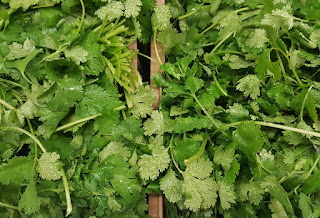Cilantro, also known as coriander or Chinese parsley, is a versatile herb used in various cuisines around the world. Here are some aspects of cilantro:
Flavor and Appearance:
Cilantro has a fresh, citrusy flavor with a hint of earthiness.
The leaves are bright green and delicate, while the stems are slender and often used in cooking as well.
Cilantro seeds, known as coriander seeds, have a different flavor profile, being warm, nutty, and slightly spicy.
Culinary Uses:
Cilantro is a key ingredient in many dishes, especially in Latin American, Asian, and Mediterranean cuisines.
It is commonly used as a garnish or ingredient in salsas, salads, guacamole, curries, soups, and sauces.
Cilantro adds a refreshing and aromatic touch to dishes, enhancing their flavor.
Health Benefits:
Cilantro is rich in vitamins A, C, and K, as well as minerals like potassium and manganese.
It contains antioxidants and may have anti-inflammatory properties.
Some studies suggest that cilantro may help lower blood sugar levels and promote heart health.
Cultural Significance:
Cilantro is deeply ingrained in the culinary traditions of many cultures, playing a prominent role in dishes like Mexican salsa, Thai green curry, and Indian chutneys.
It has a polarizing flavor, with some people loving its vibrant taste and others finding it soapy or unpleasant due to genetic factors.
Whether you enjoy its vibrant flavor or not, cilantro remains a popular and versatile herb in kitchens worldwide, adding a fresh and aromatic dimension to a wide range of dishes.
Cilantro offers several potential health benefits:
Antioxidant Properties:
Cilantro contains antioxidants such as flavonoids, phenolic compounds, and vitamin C, which help neutralize harmful free radicals in the body, reducing oxidative stress and inflammation.
Detoxification Support:
Some compounds in cilantro, such as chlorophyll and certain essential oils, may aid in detoxification by binding to heavy metals and facilitating their elimination from the body.
Digestive Health:
Cilantro may promote digestive health by stimulating the production of digestive enzymes and aiding in the breakdown of food. It also has antimicrobial properties that may help combat harmful bacteria in the digestive tract.
Heart Health:
Studies suggest that cilantro may have potential benefits for heart health. It may help lower levels of LDL cholesterol and triglycerides, reducing the risk of cardiovascular disease.
Blood Sugar Regulation:
Some research indicates that cilantro may have hypoglycemic effects, helping to lower blood sugar levels. This could be beneficial for individuals with diabetes or those at risk of developing the condition.
Anti-Inflammatory Effects:
Compounds found in cilantro, such as linalool and geraniol, have anti-inflammatory properties that may help reduce inflammation in the body, potentially alleviating symptoms of conditions like arthritis.
Skin Health:
The antioxidant and anti-inflammatory properties of cilantro may contribute to healthier skin. Some people use cilantro topically or consume it regularly to help with skin conditions like acne or eczema.
Immune Support:
The vitamin C content in cilantro supports the immune system, helping the body defend against infections and illnesses.
While cilantro offers these potential health benefits, individual responses may vary. It's essential to incorporate a variety of nutritious foods into your diet to support overall health and well-being.
Cilantro is a versatile herb used in various culinary applications. Here are some common ways it's used:
Garnish:
Cilantro leaves are often used as a garnish to add freshness and color to dishes like soups, curries, tacos, and stir-fries.
Salsas and Chutneys:
Cilantro is a key ingredient in many salsas, chutneys, and relishes, adding a bright and herbal flavor to the condiments.
Salads:
Chopped cilantro leaves can be tossed into salads to add a refreshing and aromatic element.
Guacamole:
Cilantro is a classic ingredient in guacamole, complementing the creamy texture of avocado with its fresh flavor.
Marinades and Sauces:
Cilantro can be blended into marinades, sauces, and dressings, enhancing their flavor profile.
Soups and Stews:
Cilantro is often added to soups, stews, and broths during cooking or as a finishing touch to impart a vibrant flavor.
Rice and Grain Dishes:
Cilantro can be stirred into cooked rice, quinoa, or other grains to infuse them with its aromatic essence.
Cocktails and Beverages:
Cilantro leaves can be muddled or used as a garnish in cocktails and mocktails for a fresh and herbaceous flavor.
Ceviche and Seafood Dishes:
Cilantro pairs well with seafood dishes, such as ceviche, adding a bright and citrusy note to the flavors.
Stir-Fries and Noodle Dishes:
Cilantro can be added to stir-fries, noodle dishes, and fried rice for a burst of freshness and flavor.
Overall, cilantro's versatile flavor and aroma make it a popular herb in many cuisines around the world, adding depth and vibrancy to a wide range of dishes.








0 Comments